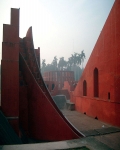Jantar Mantar
Archaeology »
Archaeological Monuments » Jantar Mantar
Jantar Mantar - India
Jantar Mantar is located in New Delhi, Delhi.
Jantar Mantar monument was established on 1710.
Primary threats to Jantar Mantar :
Observatory is consisting of mason-built astronomical instruments to chart the course of the heavens.
Historical facts of Jantar Mantar :
- Jantar Mantar is an extraordinary astronomical observatory located in the heart of New Delhi, India. Built by Maharaja Jai Singh II of Jaipur in the 18th century, it stands as a remarkable testament to India's scientific and architectural prowess. Jantar Mantar, which translates to "instrument for calculation," is an ensemble of astronomical instruments designed to study and observe celestial bodies with exceptional precision.
- Constructed between 1724 and 1730, Jantar Mantar was part of Maharaja Jai Singh II's grand plan to create five observatories in different cities across India. The purpose of these observatories was to gather accurate data on astronomical phenomena, particularly the movement of celestial bodies and the measurement of time. The other four observatories were built in Jaipur, Ujjain, Varanasi, and Mathura, but the one in Delhi remains the most significant and well-preserved.
- The architectural marvel of Jantar Mantar consists of thirteen distinct instruments, each serving a specific purpose in astronomical measurement. These instruments are colossal structures made primarily of stone and marble, displaying intricate detailing and precision in their design and construction. They were designed based on ancient Indian and Islamic astronomical principles and incorporated both traditional and contemporary elements.
- The most prominent instrument in Jantar Mantar is the Samrat Yantra, also known as the Giant Sundial. It is the largest sundial in the world, standing at a height of 27 meters. The Samrat Yantra can accurately measure the time of day, declination of the sun, and the equinoxes and solstices. It consists of a massive triangular gnomon with inclined ramps and calibrated markings on the ground. As the sun moves across the sky, its shadow falls on the ramps, indicating the time with remarkable precision.
- Another fascinating instrument in Jantar Mantar is the Jai Prakash Yantra, a hemispherical structure with concave walls and numerous small holes. Through these holes, astronomers can observe the positions and movements of celestial bodies, including stars and planets. The Jai Prakash Yantra enables accurate measurement of celestial altitudes and azimuths.
- The Misra Yantra, a combination of several instruments, is designed to measure the shortest and longest days of the year, as well as the precise time of noon in different cities. It consists of a set of intersecting arches, columns, and shadow-casting arms. By observing the shadows cast by these elements, astronomers can determine the exact moment of noon and the tilt of the Earth's axis.
- Jantar Mantar's instruments are not only remarkable in their functionality but also in their contribution to astronomical knowledge. They have played a crucial role in advancing our understanding of the heavens and the Earth's place in the universe. Maharaja Jai Singh II was a dedicated astronomer himself, and his vision for Jantar Mantar was to create a scientific hub where astronomers could make accurate observations and conduct groundbreaking research.
- Today, Jantar Mantar stands as a UNESCO World Heritage site and a popular tourist attraction. It serves as a reminder of India's rich scientific heritage and the advancements made in the field of astronomy centuries ago. Visiting Jantar Mantar allows visitors to marvel at the architectural genius and appreciate the precision with which these instruments were designed to unravel the mysteries of the cosmos.
- In conclusion, Jantar Mantar is a historically significant astronomical observatory in New Delhi, India, built by Maharaja Jai Singh II in the 18th century. Its thirteen unique instruments, including the Giant Sundial and the Jai Prakash Yantra, showcase India's scientific and architectural brilliance. Jantar Mantar's contribution to the study of celestial bodies and time measurement cannot be overstated, and its preservation as a UNESCO World Heritage site ensures that its historical significance is appreciated by generations to come.

